The New York State Chess Association’s
Mid-Summer Meeting at
Saratoga Springs 1899
by John S. Hilbert
|
|
| The New York State Chess Association (NYSCA) had,
even before time took its sharp turn into the Twentieth Century, an established
history of holding what it referred to as “mid-summer” association meetings.
The term “mid-summer” is set off by quotation marks to emphasize that,
by 1899 at least, the meetings were held at the end of August and beginning
of September, and hence could hardly, even under the most charitable calendar
reading, be considered near the middle of summer. Such events were
frequently, if not invariably, held outside of New York City, and often
were held at summer resorts such as the meetings at Thousand Islands 1897
and Lake Keuka 1898. In 1901, for another example, the association’s
mid-summer meeting was held in Buffalo, New York, then the scene of the
1901 Pan-American Exposition. Seven years earlier, play had also
been held in the Queen City, and in later years other upstate locations,
including Rochester, would be the summer playgrounds of the NYSCA. |
| The events held in the late 1890s, however, are
unusual for another reason. Rather than remaining purely the province
of New York players, players from other state associations, notably Pennsylvania,
but also Massachusetts, were actively lobbied to attend the NYSCA’s mid-summer
sessions. Indeed, a lively interstate rivalry developed between the
players of New York and those of Pennsylvania. |
| The genesis of interstate rivalry involving New
York and Pennsylvania is explained in large measure by the fact that, at
one time, the group was originally the New York and Pennsylvania
State Chess Association. Only later did this group merge in the NYSCA.
And according to Gustavus Reichhelm, then chess editor for the Philadelphia
Times and author of Chess in Philadelphia (1898), “the original
members,” including all the Pennsylvania players, “retained their right
of membership.” Thus players such as Kemeny, Shipley, Bampton, Voigt
and others, though residents of Pennsylvania, were permitted entry into
NYSCA events. |
| And the Philadelphian’s often participated successfully.
In September 1886, for example, a small, double round tournament sponsored
by the combined state association in Cooperstown was won by Shipley.
At Skaneateles in August 1892, Shipley and Voigt tied for top honors, with
Voigt entering the handicap event to determine the overall winner of the
Association when Shipley had to return to his home in Germantown.
At Buffalo 1894, Shipley again won the Association title, though the meeting
is much better remembered for the Masters’ event, where Showalter managed
to out point Pillsbury, Albin, and Buffalo’s own representative, George
C. Farnsworth. S. W. Bampton emerged the winner as Skaneateles 1895,
and repeated his achievement the next year at Ontario Beach, with Shipley
trailing him by a mere half point. |
| An innovation occurring in 1897 would have significant
consequences for the NYSCA during the remaining years of the century.
Walter Penn Shipley wrote the Board of Managers of the NYSCA that spring,
suggesting that instead of a purely individual event, the 1897 meeting,
held at the Murray Hill Hotel in Thousand Islands from August 2-7, 1897,
be a modified team event. The seven players selected from each state
organization would, in the course of seven rounds, meet all seven of the
other team’s players. Individual prizes would be given for the best
scores made, while the aggregate score of each state would serve to determine
who won the interstate match. |
| Shipley’s idea was taken up and Thousand Islands
saw what was undoubtedly the strongest of the interstate meetings, notably
because of the presence of United States Champion and internationalist
Harry Nelson Pillsbury as well as former champion* Albert B. Hodges in
the ranks of the New York players. While Pillsbury and Hodges between
them amassed a notable 12½-1½ score, with Pillsbury giving
up only a draw to Shipley and Hodges tasting defeat but once, against Charles
John Newman, the New York team managed to win the team event by the much
smaller margin of 25½-23½. |
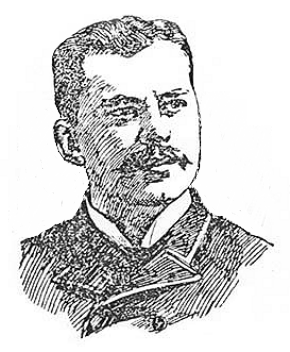 |
A. B. Hodges
|
|
| Certainly Shipley deserved his draw against Pillsbury,
then one of the finest players in the world. According to the Philadelphia
Public Ledger for August 28, 1897, where the game appeared in Emil
Kemeny’s column, it was noted that “Mr. Shipley was the only one on the
Pennsylvania team who succeeded in holding his own against Pillsbury.
The game was a splendidly contested one. Pillsbury, to some extent,
gained the upper hand, and for a number of moves it looked as though he
would win. Mr. Shipley, however, defended skillfully, and when forty-six
moves were made a draw was offered and accepted. The game abounded
in interesting complications, and the play was a very creditable one to
both parties.” Additional notes from Reichhelm’s Chess in Philadelphia
are separately identified in the game below. |
|
Shipley,WP (Pennsylvania) — Pillsbury (New York)
|
Round 1
|
| 1897.08.03 |
USA Thousand Islands, NY (Interstate Team
Match)
|
|
Annotations by Emil Kemeny & Gustavus
Reichhelm
1.e4 e5 2.Nf3 Nc6 3.d4 exd4 4.Nxd4 Nf6 5.Nxc6 bxc6 6.Bd3
d5
| Kemeny: Better than 6...d6, which gives Black a rather slow
development. |
| Reichhelm: Playing conservatively
against so powerful an adversary. |
 17.Rfe1
17.Rfe1
| Kemeny: White could not play 17.Qxd5 on account of 17...Bxh2+
and 18...Qxd5. The text move is a pretty strong one, yet 17.Rad1 attacking
the d-pawn was a more aggressive one. Black had hardly any better
reply than ...d4, and White might have obtained the superior position by
continuing 18.Rfe1 and eventually c3. White having selected the more
conservative 17.Rfe1 play his opponent has time to answer ...Qc6 and ...c4
with a good game. |
| Reichhelm: Characteristically making
a push for a win, but Mr. Shipley meets it with great accuracy. |
| Kemeny: Well played. White cannot exchange queens, for
he would be unable to guard the c-pawn. |
| Reichhelm: Foreseeing that he can
regain the pawn lost by this. |
| Kemeny: As a rule, a knight is of more value in the endgame
than a bishop. In the present position White should have the advantage
mainly on account of Black’s weak e-pawn. Yet Black, having his king
in commanding position, can pursue aggressive tactics, and it requires
skill and accuracy on White’s part to avoid defeat. |
 44.g3
44.g3
| Kemeny: An important move, which enables White to maintain the
Ne3 play. Had he move 44.Ne3 at once Black’s answer would have been
...g3, with a winning game. |
| Reichhelm: If Black now moves 46...Kc4,
White responds 47.Kd2, and keeps the black king out. |
|
Philadelphia Public Ledger, 1897.08.28
|
|
Chess in Philadelphia, Philadelphia
1898, p115
|
|
| In addition to the interstate match up, Thousand
Islands 1897 featured competition for the Staats Zeitung Chess Cup, an
event then in its seventh year. The cup itself had been donated by
the New Yorker Staats Zeitung, a German language newspaper based
in New York City. Only three players competed for the cup at Thousand
Islands, each representing their home chess club, but the three were certainly
among the strongest players in the United States: ex-world champion William
Steinitz represented the Staten Island Chess Club, while S. Lipschütz,
from the Manhattan Chess Club, and the sixteen year old phenomenon, William
Ewart Napier, from the Brooklyn Chess Club, made up the field. A
wonderful photograph of the three of them, with Steinitz and Lipschütz
playing a game and Napier sitting by the board, with among others the Philadelphians
Shipley and D. Stuart Robinson looking on, graces the pages of the August
1897 issue of the American Chess Magazine. |
| The interstate aspect of the 1897 mid-summer meeting
was so popular that the following year, at Lake Keuka, New York, the NYSCA
repeated its experiment. The Association’s mid-summer meeting at
Lake Keuka was held August 8-13, 1898, and though neither Pillsbury nor
Hodges, nor even Shipley, attended that gathering, strong and entertaining
play took place nevertheless. A young Frank J. Marshall participated,
but found himself largely outclassed, losing to five of the seven Pennsylvania
players, and indeed the New York squad as a whole was severely manhandled,
losing the team event by a lopsided 30-19. |
| While Pillsbury didn’t play, he did annotate the
following game for the pages of the September 1898 American Chess Magazine. |
|
Kemeny,E (Pennsylvania) — Delmar,E (New York)
|
Round 6
|
| C41/10 |
Philidor: Jaenisch (Hanham)
|
|
| 1898.08 |
USA Lake Keuka, NY (Interstate Team Match)
|
|
Annotations by Harry N. Pillsbury
1.e4 e5 2.Nf3 d6 3.d4 Nf6 4.Nc3
| The attack by 4.dxe5 Nxe4 5.Qd5 would be premature, for after 5...Nc5
Black threatens to gain important time for development by either 6...c6
or 6...Be6, followed by 7...d5. Any attempt by White to force matters
by 6.Ng5 would fail: 6...Qe7 7.Bc4 f6!! 8.Qf7+ Qxf7 9.Nxf7 b5, Black eventually
remaining with two pieces for rook. |
| 6.Bc4 followed by Qd3 and a4 seems a more aggressive development.
Black could hardly continue 6.Bc4 Nxe4 7.Bxf7+ Kxf7 8.Nxe4 etc., as White
obtains the first attack in the center. |
| Black’s eighth move fully equalized matters, but here he goes wrong.
Simply 10...0-0 reserving the capture of the bishop, gave a good game. |
| It was far preferable to continue 11...exd4 12.Bxd4 (12.Bf4 Qd8 13.Bd6
Nf6 etc.) 12...f6 13.Nf4 Nb6 retaining equal forces, although White still
has the better game. |
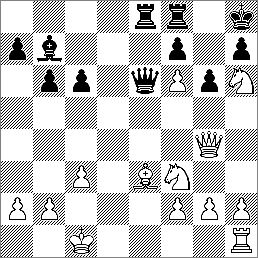 20.Qxe6
20.Qxe6
| White could also win by 20.Ng5 Qxf6 21.Qd7 etc., or by 20...Qxg4 21.Ngxf7+
Rxf7 22.Nxf7+ Kg8 23.Nh6+ etc. But it was simply a question of methods,
as either way wins easily. |
|
American Chess Magazine, 1898.09
|
|
| Of course, such a drubbing at Lake Keuka demanded
revenge, and so in late August 1899 the New York team was looking to take
the measure of their colleagues from further south. One additional
feature for the 1899 event, however, was the attempt to include a team
from Massachusetts, thereby making the competition a three-way quest for
victory. |
| Indeed, as late as July 1899 the proposed three
way match involving New York, Pennsylvania, and now Massachusetts was being
touted in the pages of the American Chess Magazine. Gustavus
Reichhelm introduced a chart in the same issue of the magazine allowing
for what he called “adequate and evenly balanced” competition among three,
seven man teams through the play of seven full and two “supplementary”
rounds. |
| But Saratoga Springs 1899 was much more than merely
an interstate chess team match. In addition to the ninth annual Staats-Zeitung
Chess Cup competition, there were to be a series of class tournaments as
well. And chess was hardly the only feature used to attract additional
members of the NYSCA to take a summer holiday at Saratoga Springs.
A circular issued by the Board of Managers of the NYSCA noted that “the
twelfth midsummer meeting and the thirty-first tournament will be held
during the week commencing August 28 at the United States Hotel, Saratoga
Springs, New York. The beauty of Saratoga Springs, the many attractions
for the members who may not enter the tournaments, and the United States
Hotel, one of the greatest hotels in this country, all promise well for
the meeting of 1899.” |
| Attractions were emphasized not only for tournament
players, but for spouses and others just interested in getting away.
Mention was made of “the hundreds of mineral springs, the beautiful cottages,
the park and the drive to the lake—are all in themselves sufficient to
repay all who attend the meeting.” Hotel rates were three dollars
a day, reduced from the usual five, and easy transportation could be arranged
by way of the Delaware and Hudson Railroad, which serviced Saratoga Springs
by way of the state capital, Albany. Special rates were also offered
for those arriving by train. |
| A special call was sent out to chess clubs for representatives
for the Staats- Zeitung Chess Cup. The rules under which the cup
was donated specified that the first club to win it five times would retain
possession of it permanently. The Manhattan Chess Club had successfully
won it on four occasions, in 1891, 1894, 1896 and 1898, and thus would
take the cup for good unless someone stepped forward to prevent that happening.
No other club had won the cup more than once. Competition in the
class tournaments would see, among other things, the determination of the
winner of the Farnsworth Cup in the First Class event. The Farnsworth
Cup had been given two years earlier by the widow of George Farnsworth,
the latter having competed at Buffalo 1894 and who had died prematurely
of a heart condition in 1896. Farnsworth, the American Chess Magazine
reported in its August number that year, “was one of the most active and
earnest supporters” the NYSCA ever had. |
| The Board of Mangers hoped at least seven or more
club
representatives would play in the ninth Staats-Zeitung Chess Cup contest.
The year before, at Lake Keuka, only two players, the young Marshall and
the veteran Lipschütz, had appeared, and a crushing, 3-0 victory by
the latter had given the Manhattan Club its fourth leg of the five needed
to retain the ornate, English made silver cup, shaped like a chess rook. |
| The August issue of the American Chess Magazine
also remarked that Aristidez Martinez, then President of the Manhattan
Chess Club, “has offered a sterling silver smoking set for the best game
played in the interstate team match, New York – Pennsylvania - Massachusetts.
It is composed of a tray, cigar-holder, ash receiver and match safe in
the finest patterns and valued at eighty dollars.” To whom the smoking
set should be awarded would become the subject of some conflict and a great
deal of paper and ink in the weeks ahead. |
| On Monday, August 28, 1899, at ten in the morning,
competition for the Staats-Zeitung Cup commenced. The Board of Managers,
however, were no doubt seriously disappointed by the turn out. They
had hoped for representatives from at least the Manhattan, Brooklyn, Albany,
Rochester, Staten Island, New York City and Buffalo chess clubs, in order
to reduce the chances of the Cup being permanently taken out of competition.
What they in fact witnessed was an exact repetition of the year before
at Lake Keuka. Only two players entered the lists, Lipschütz
once more representing the Manhattan Chess Club, and Frank Marshall once
again representing the Brooklyn Chess Club. |
| It was decided that the player to win a five game
match would take the cup home to his club, but like the year before, only
three games were required to decide who would possess the Staats-Zeitung
Cup. There had, though, been some hope Marshall would in this, his
second chance, make a better showing against the much more experienced
Lipschütz. Emil Kemeny, for example, writing on August 29, 1899,
in his column in the Philadelphia Public Ledger, had said that while
it was true the older man had beaten Marshall decisively the year before,
“Marshall since has established quite a reputation for himself by winning
first prize in the London Minor Tourney, and the Brooklyn Chess Club hoped
that he would square accounts with Lipschütz.” The Brooklynites,
however, were to be seriously disappointed. |
| The American Chess Magazine for September
1899 provided all three games with significant annotations, though from
the color sequence and other sources, notably the New York Sun for
September 10, 1899, which also ran the scores of the three games, the American
Chess Magazine had mistakenly switched games one and two. But
regardless of the precise ordering of the first two games, Lipschütz
jumped out to an early lead over his opponent. |
|
Lipschütz,S (Manhattan) — Marshall,FJ (Brooklyn)
|
Game 1
|
| 1899.08.28 |
USA Saratoga Springs, NY (Staats-Zeitung
Cup Tournament)
|
|
Annotations from the American Chess
Magazine
1.e4 e5 2.Nc3 Nf6 3.f4 d5 4.fxe5 Nxe4 5.Nf3 Bg4 6.Be2
| So far a generally accepted version. |
| To draw on the d-pawn and get it within reach of the c-pawn.
White might otherwise play d3 and effectively dislodge the knight from
e4. |
| 10...Bxc3, followed by ...c4, would not improve his position to any
extent, although apparently causing a block. As will be seen, Black
later on regains the pawn he now relinquishes. |
| 17.Nxe4 would cost him a piece, as Black then plays ...Rae8, ...Qd4+,
and ...f5 in due order. |
| Guarding against the check at b3 in reply to the contemplated ...f5. |
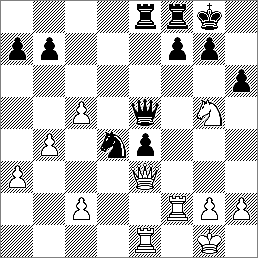 20.Nh3
20.Nh3
| Fearing the complications attending the capture of the e-pawn, White
retreats circumspectly. In this he was wise, as the following interesting
variations show: 20.Nxe4 f5 21.Rd2 (21.Rd1 Ne6 also leaves White’s knight
open to capture.) 21...Nc6 22.Qb3+ Kh8 and the knight cannot be saved. |
| He is forced to advance the pawn or else lose it at once. Advanced
thus far its chances for longevity are very slim, however. |
| He could also play 22.Qxe5 exf2+ 23.Kxf2 Rxe5 24.Rxe5 the rook getting
to the seventh a move or two later. But, instead of 22...exf2+, Black
could retake the queen at once and gain time for the defense of the e-pawn.
Moreover, the text move of White enables him more quickly to compass the
downfall of the disputed pawn. |
| Forcing his hand and Black must either move the knight or resort to
the move in the text. It is doubtful whether the latter is the wiser
course, inasmuch as White’s pawns are undoubled and strengthened in the
process. Black retains his e-pawn, but he, nevertheless, finds himself
a good way behind in the race. |
| Better than advancing the pawn, the Black king being held longer in
check. |
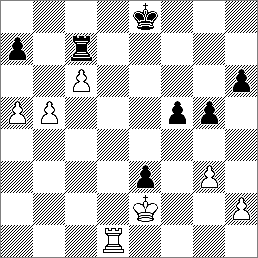 41.Rd6
41.Rd6
| Evidently he does not propose to take any chances and is making assurance
doubly sure. He could also play 41.Kxe3 and if 41...a6 42.b6 Rxc6
43.b7 f4+ 44.gxf4 gxf4+ 45.Ke4 and White’s b-pawn cannot be stopped. |
| Again, he could advance the pawn to b6, but there is no reason why,
with the game in hand, he should not adopt the more conservative course.
The rest now becomes plain sailing, the victory being in every respect
well earned. |
|
American Chess Magazine, 1899.09
|
|
New York Sun, 1899.09.10
|
|
| After being outplayed in a rook and pawn endgame,
Marshall turned to the Scotch Gambit to try and reverse his fortunes.
The result, however, was hardly the one he was hoping for. |
|
Marshall,FJ (Brooklyn) — Lipschütz,S (Manhattan)
|
Game 2
|
| C44/05 |
Scotch: Gambit (Haxo)
|
|
| 1899.08 |
USA Saratoga Springs, NY (Staats-Zeitung
Cup Tournament)
|
|
Annotations from the American Chess
Magazine
1.e4 e5 2.Nf3 Nc6 3.Bc4 Bc5 4.d4 exd4 5.0-0 d6
| 5...Nf6 would lead to the Max Lange Attack proper, White continuing
with 6.e5. Its adoption by Black, however, entails exposure to a
somewhat harassing attack. In view of the fact that there are still
new variations cropping up from time to time it is safer to avoid it in
important games. |
| Best, for if he plays 7...Qe7 White continues with 8.Nxc3 Nf6 9.Bg5
and if then 9...0-0 10.Nd5 Qd8 11.Nxf6+ gxf6 12.Bh6 and he cannot save
the exchange. |
| 8...Nf6, instead of the text move, was not bad at this stage, but Black
disliked the prospect of Bg5 on the part of White in reply. In that
case, however, he could have continued with ...Qe7, since there was no
knight handy to enter at d5. |
| Marshall is of the opinion that this and the next move lost him much
valuable time. 9.h3 followed by Nh4 would have given him quite a
strong game. |
| 13.Nd4 at once was to be preferred. |
| It has required considerable maneuvering to enable Black finally to
castle, but now to all appearances, the king is safely housed. |
| The deployment of the rook meets with no success and merely causes
White to lose ground. The piece would have been better posted at
c1. 17.Nf5 would likewise be much to the point. |
| Even now Nf5 is excellent because if Black counters with ...Bxf5, White
will get the open e-file and sooner or later, entrench a piece at e6 with
telling effect. |
| 19.f5 is necessary here to hold the position, though the move has theoretically
an uninviting look. |
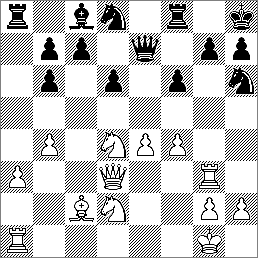 20…c5
20…c5
| Very appreciably opening up his position, which so far had been not
a little cramped. From now on he gains at every step. |
| The king is now cornered, but quite inaccessible and his retreat is
pretty thoroughly covered. |
| 25.fxe5 at once was better, though Black in any event retains his hold
on the game. |
| Fatal, of course, but he had no alternative, Black threatening the
destructive check at f2. |
| The surest method of winning quickly. If 31...Nxf3+ 32.Rxf3 Qb6+
33.Qe3 Qxe3+ 34.Rxe3 Bc4 35.Bd3 and he still has a fighting chance for
his life. |
| There is no good move now left to him. 36.g3 is met by 36...Rf1+
37.Kg2 Rf2+ 38.Kh3 h5 threatening both the mate and the win of the piece
by ...Bxb5 and ...Rxc2. |
|
American Chess Magazine, 1899.09
|
|
| With a commanding 2-0 lead, Lipschütz could
have easily coasted into victory for the Staats-Zeitung Cup by drawing
the third game, but the Manhattan Club player’s juggernaut was not about
to be stopped by Marshall’s play, which many considered radically below
the form he had shown earlier in the year when he won the Minor tournament
at London 1899 with a score of 8½-2½ over a field that included
the likes of Mieses and Marco. But whatever his form, Marshall stood
no real chance against Lipschütz, who at Saratoga would give up only
one draw among his many games. |
|
Lipschütz,S (Manhattan) — Marshall,FJ (Brooklyn)
|
Game 3
|
| D00/04 |
Queen’s Pawn: Stonewall (Showalter)
|
|
| 1899.08 |
USA Saratoga Springs, NY (Staats-Zeitung
Cup Tournament)
|
|
Annotations from the American Chess
Magazine
1.d4 d5 2.e3 e6 3.Bd3 Bd6 4.f4 f5 5.Qh5+
| This “following the leader” game might be kept up indefinitely in this
opening without serious injury to either party, but White concludes to
try another tack. His purpose in checking is to post his queen on
the kingside, handy in case opportunity for an onslaught offers itself. |
| Threatening both ...Bxf4 and ...Nb4. |
| At once defensive and offensive. White in turn threatens Nxg6. |
| Forced; otherwise Black wins the d-pawn with knight. |
| 13.Nb5 would be met by ...Nxe5, etc. White, when this game was
played, had the advantage of being able to play for a draw, hence he is
not backward about offering an exchange of queens. In fact, he practically
forces it here. |
| He cannot afford to retreat, because White would in that case force
an entrance with his knight at d6. |
| Preventing Black castling for the time being, at least. Should
Black castle next move, White continues with Nc4, and either reaches d6
or wins a pawn. |
| White might have hindered this advance by posting his bishop at b6.
The subsequent play works out, however, to his advantage. |
| Having a theoretical advantage in the possession of two bishops, he
proceeds to create avenues to develop fully their usefulness. |
| Evidently to induce the advance of the a-pawn, but he later errs in
capturing this same pawn at an inopportune moment. |
| Had he retired the bishop to a6 the following variation might have
occurred: 23...Ba6 24.b4 axb4 25.cxb4 c3 26.Bxa6 cxd2 27.Rxc8+ Nxc8 28.Bxd2
and an interesting struggle to obtain the upper hand on the queenside would
ensue, in which White at least could do no worse than draw. |
| Decidedly not as good as 24...dxc4, which would have left him with
a fairly playable game. In that case White’s best course would be
to occupy d6 with rook. |
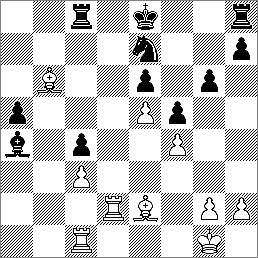 26.Bxc4
26.Bxc4
| Pretty play. Black, of course, cannot retake bishop on account
of Rd8+ winning the king’s rook. |
| White threatened Rd6, hence Black must let the a-pawn go. |
| Poor; 30...Rb8 was the proper move and would have somewhat retarded
White, though not seriously, as the doubling of the rooks, followed by
Bb4, would leave the position still in White’s hands. |
| The beginning of the end, Black being utterly unable to ward off the
impending blow. |
|
American Chess Magazine, 1899.09
|
|
| And so after three games, and a 3-0 shellacking
of the Brooklyn representative, the Manhattan Chess Club took permanent
possession of the Staats-Zeitung Chess Cup, winning it for the fifth time
in the nine years the cup was in competition. Both Lipschütz
and Marshall played in the interstate match as well, though there is no
suggestion their dual play in both the Cup and interstate matches compromised
either’s form. |
| The interstate match, so grandly announced beforehand
to be a three way competition, also found itself somewhat less than hoped
for, in that the Massachusetts players did not materialize. According
to the American Chess Magazine, “the withdrawal of the Massachusetts
contingent was a source of sincere regret and undoubtedly militated in
some degree against the success of the meet, but not seriously so, thanks
be to the gods.” For indeed the competition between New York and
Pennsylvania in truth more than made up for the absence of the third state
contingent. |
First Round, Tuesday, August 29
| New York |
|
Penn. |
| Karpinski |
0-1
|
Kemeny |
| Weeks |
0-1
|
Robinson |
| Hanham |
0-1
|
Young |
| Roething |
1-0
|
Voigt |
| Marshall |
0-1
|
Bampton |
| Halpern |
½-½
|
Shipley |
| Lipschütz |
1-0
|
McCutcheon |
Total NY 2½ PA 4½
|
 |
W. P. Shipley
|
Play during the interstate meet was “arranged so
that the players are scheduled for games during the morning and evening
hours, the afternoons being given to recreation.” This schedule was
considered neither taxing nor irksome. But after the conclusion of
the first round, no doubt the New York contingent felt they might be in
for another drubbing like they had received the year before at Lake Keuka.
Three games have been recovered from the first round. The first,
the draw between Halpern and Shipley, appeared in the Brooklyn Daily
Eagle for August 31, 1899. |
|
|
Halpern,JC (New York) — Shipley,WP (Pennsylvania)
|
Round 1
|
| 1899.08.29 |
USA Saratoga Springs, NY (Interstate Team
Match)
|
|
1.e4 e5 2.Nf3 Nf6 3.Nxe5 d6 4.Nf3 Nxe4 5.d4 d5 6.Bd3 Be7
7.0-0 Nc6 8.c3 Bg4 9.Bf4 0-0 10.Nbd2 f5 11.Qc2 Bd6 12.Bxd6 Qxd6 13.Ne1
Qf4 14.Nb3 Bh5 15.f3 Nd6 16.Qf2 Rae8 17.Nc2 Bf7 18.Nc5 Be6 19.Ne3 Qh6 20.Nxe6
Qxe6 21.Rfe1 f4 22.Ng4 Qf7 23.Qh4 h6 24.Qh3 Rxe1+ 25.Rxe1 Re8 26.Ne5 Nxe5
27.dxe5 Qe6 28.Qh5 Re7 29.Re2 Nf7 30.g3 fxg3
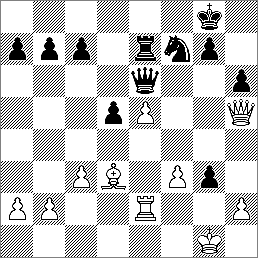 31.f4 gxh2+ 32.Kxh2 Nh8 33.f5 Qf7 34.Qg4 Kf8 35.Kg1 c5
36.f6 gxf6 37.Qc8+ Qe8 38.Qxc5 Qc6 39.Qf2 Qb6 40.Qxb6 axb6 41.exf6 Rxe2
42.Bxe2 Kf7 43.Bf3 Ke6 44.Kf2 Nf7 45.Ke3 Ne5 46.Bg2 Ng4+ 47.Kd4 Nxf6 48.c4
½-½.
31.f4 gxh2+ 32.Kxh2 Nh8 33.f5 Qf7 34.Qg4 Kf8 35.Kg1 c5
36.f6 gxf6 37.Qc8+ Qe8 38.Qxc5 Qc6 39.Qf2 Qb6 40.Qxb6 axb6 41.exf6 Rxe2
42.Bxe2 Kf7 43.Bf3 Ke6 44.Kf2 Nf7 45.Ke3 Ne5 46.Bg2 Ng4+ 47.Kd4 Nxf6 48.c4
½-½.
|
Brooklyn Daily Eagle, 1899.08.31
|
|
| The Brooklyn Daily Eagle, not surprisingly,
also published Lipschütz’s win over McCutcheon in the same, August
31, 1899, column. |
|
Lipschütz,S (New York) — McCutcheon,JL (Pennsylvania)
|
Round 1
|
| C12/01 |
French: McCutcheon
|
|
| 1899.08.29 |
USA Saratoga Springs, NY (Interstate Team
Match)
|
|
1.e4 e6 2.d4 d5 3.Nc3 Nf6 4.Bg5 Bb4 5.exd5 Qxd5 6.Nf3
Ne4 7.Bd2 Bxc3 8.bxc3 Nxd2 9.Qxd2 c5 10.Be2 cxd4 11.cxd4 Nc6 12.0-0 0-0
13.c3 Bd7 14.Rab1 Na5 15.Ne5 Bc6 16.Bf3 Qd6 17.Nxc6 bxc6 18.Qe2 Rab8 19.Qa6
Rxb1 20.Rxb1 Rb8 21.Ra1 Qc7 22.g3 Rb5 23.a4 Rg5
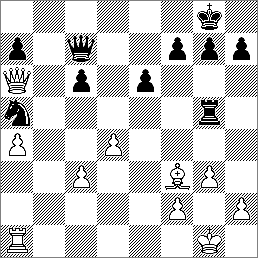 24.h4 Rxg3+ 25.fxg3 Qxg3+ 26.Bg2 Qe3+ 27.Kh1 g6 28.Rb1
Qxc3 29.Qxa7 Nc4 30.Rf1 f5 31.Rb1 Nb2 32.Qb8+ Kg7 33.Qxb2 1-0.
24.h4 Rxg3+ 25.fxg3 Qxg3+ 26.Bg2 Qe3+ 27.Kh1 g6 28.Rb1
Qxc3 29.Qxa7 Nc4 30.Rf1 f5 31.Rb1 Nb2 32.Qb8+ Kg7 33.Qxb2 1-0.
|
Brooklyn Daily Eagle, 1899.08.31
|
|
| A third game from this round was published in the
Philadelphia
Public Ledger for September 20, 1899. Like all the games from
the Ledger, this one was annotated by Emil Kemeny, who not only
could appreciate the quality of play he saw, but was himself deeply involved
in the interstate match. The introduction in the
Ledger stated
that “the game between Bampton and Marshall in the Interstate contest,
held at Saratoga, was won by the former. Marshall adopted the Max
Lange Attack. On his sixteenth turn he failed to select the strongest
move, and Bampton quickly took advantage. The continuation was very
lively, and the Philadelphian soon obtained the attack, which he pursued
vigorously, bringing about a win in the shortest possible order.” |
|
Marshall.FJ (New York) — Bampton,SW (Pennsylvania)
|
Round 1
|
| C55/05 |
Two Knights: Lange (Marshall)
|
|
| 1899.08.29 |
USA Saratoga Springs, NY (Interstate Team
Match)
|
|
Annotations by Emil Kemeny
1.e4 e5 2.Nf3 Nc6 3.Bc4 Bc5 4.d4 exd4
| Safer is 4...Bxd4. White then continues 5.Nxd4, 6.0-0, and 7.f4,
with some attack. The play selected leads to a lively variation,
in which White used to win a piece for three pawns—a result quite satisfactory
to Black. Of late, however, a stronger continuation has been found
for White, which seems to win. |
| The only move he has. 9...Qxf6 would have lost a piece, since
Nxe6, followed by Qh5+ and Qxc5 was threatening. |
| A powerful move, which prevents Black from castling. The play
was successfully adopted by Chigorin against Teichmann in the first round
of the London tourney. |
| Premature play, which gives Black a winning game. The correct
play was Qf3, White then threatens Nf6+ and eventually Rxe6. |
| It is quite noteworthy that Qf3 could not be played now. Black
answers ...Qxg5, and if White continues Ne4+ or Nh7+, then Black moves
...Qf5. Black thus would win a piece. |
| White loses a piece, but there was no way of saving it. The bishop
could not be guarded, and, if White retreats the bishop, his knight will
be unguarded. The play selected is the best, for White gets the exchange. |
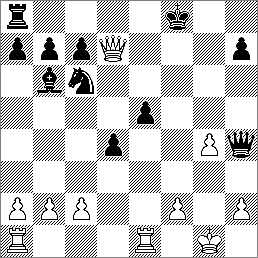 22…d3
22…d3
| Well played. This aggressive move opens the diagonals for the
bishop, enables Black to bring his knight into action and forces White
to the defense. |
| Much better than ...Nf3, which would have been answered by Qd7+, giving
White a winning game. |
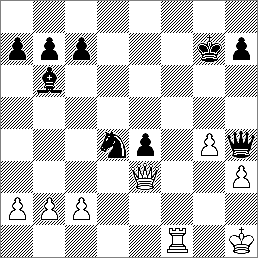 30…Ne2
30…Ne2
| The decisive move, which completely demolishes the White position.
The queen is attacked and White must guard against Qxh3 mate. If
White moves Qb3 or Qa3, then ...Ng3+ wins the rook. |
|
Philadelphia Public Ledger, 1899.09.20
|
|
Second Round, Tuesday, August 29
| Penn. |
|
New York |
| Kemeny |
0-1
|
Lipschütz |
| Robinson |
½-½
|
Karpinski |
| Young |
0-1
|
Weeks |
| Voigt |
½-½
|
Hanham |
| Bampton |
1-0
|
Roething |
| Shipley |
½-½
|
Marshall |
| McCutcheon |
0-1
|
Halpern |
Total PA 2½ NY 4½
|
| The evening session proved as much a disaster for
the Pennsylvania players as the morning one had for the New Yorkers.
Lipschütz defeated Kemeny, perhaps his strongest competitor, to increase
his interstate score to 2-0. By defeating Roething, Bampton, on the
Pennsylvania side, matched Lipschütz by maintaining a perfect record,
but his victory was the only one his team could boast of that night.
And Marshall finally scored a half point, drawing with Pennsylvania team
captain Walter Penn Shipley. The tired combatants went to bed with
the overall score deadlocked at 7-7. |
| One game has survived from this round, and not surprisingly,
it involved perhaps the two strongest players at the event. Kemeny
himself annotated his loss for his readership in his September 15, 1899,
Philadelphia
Public Ledger column. The Ledger introduced that contest,
noting that “the game between Lipschütz and Kemeny in the recent interstate
contest held at Saratoga was a Ruy Lopez, resulting in victory for the
former. The game was strongly contested, and resulted in a pretty
even ending. From the fortieth move to the fifty-second Kemeny had
many opportunities to draw the game, but he partly avoided and partly missed
them. Lipschütz thus won a pawn and the game. Lipschütz
played the ending flawlessly.” |
 |
S. Lipschütz
|
|
|
Lipschütz,S (New York) — Kemeny,E (Pennsylvania)
|
Round 2
|
| C67/07 |
Spanish: Open Berlin
|
|
| 1899.08.29 |
USA Saratoga Springs, NY (Interstate Team
Match)
|
|
Annotations by Emil Kemeny
1.e4 e5 2.Nf3 Nc6 3.Bb5 Nf6 4.0-0 Nxe4 5.d4 Be7 6.Qe2
Nd6 7.Bxc6 bxc6 8.dxe5 Nb7 9.Nc3 0-0 10.Bf4
| 10.Re1 is considered stronger. The text move is answered by ...Nc5,
Black threatening ...Ba6. The White bishop will subsequently be attacked
by ...Ne6. |
 18.Ba7
18.Ba7
| 18.Na4 might have been played, followed eventually by b4, weakening
the Black c-pawns. Black, however, had the open b-file, and by playing
...a5, followed eventually by ...Ba6 or ...Rb5, he might have relived his
position. The play adopted is hardly inferior to Na4. |
| 22...Bxb2 could not be played on account of 23.c3 winning a piece. |
| Better perhaps was 29.h3. The move selected gives Black an opportunity
to establish some attack on the kingside. |
| 35.g4+ followed by Ne5 would have drawn the game, since bishops of
opposite colors would remain on the board. |
| 40.Nxd6 followed by Ke3 would have drawn the game. White, of
course, could not play Ke3, for ...Bxg3 would follow. |
| An inferior move which gives Black an advantage, e5 should have been
played, giving up the pawn. White then with a knight against bishop
could easily draw the game, especially since the Black pawns are doubled. |
| 43.Bd2 would have still drawn the game. If Black answers ...Bd4+,
then Be3 is played by White. If, however, ...Be5, then Nxe5 and Ke3
follow. The text move compromises the White game and will cause the
loss of the e-pawn. |
| He could not well play 51...Bg1 and ...Bxh2, for White will move Kf2,
and the bishop is closed in. Nor could he well play 51...Bc3+ and
...Bxb4, for in that case White has the Nf6+ continuation on hand, winning
the g-pawn. The text move is the strongest play he had. |
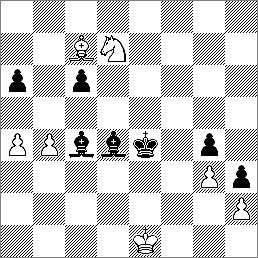 52.Bb6
52.Bb6
| A disastrous mistake which loses the b-pawn and the game. Instead
of Bb6 he should have played Bd6, and Black could make no headway.
If he moves ...Kf3 or ...Kd3, then Ne5+ follows. If, however, Ke3,
then Bb6 brings about an exchange. |
| The game at this stage is hopeless. White cannot guard the a-pawn,
and with two pawns to the good, Black forces a win quite easily. |
|
Philadelphia Public Ledger, 1899.09.15
|
|
Third Round, Wednesday, August 30
| New York |
|
Penn. |
| Halpern |
½-½
|
Kemeny |
| Lipschütz |
1-0
|
Robinson |
| Karpinski |
0-1
|
Young |
| Weeks |
½-½
|
Voigt |
| Hanham |
0-1
|
Bampton |
| Roething |
½-½
|
Shipley |
| Marshall |
1-0
|
McCutcheon |
Total NY 3½ PA 3½
|
| The third round, played Wednesday morning, saw no
change in the team standings, as the round was evenly split, 3½-3½,
resulting in another tie for the teams in total score as well, at 10½-10½.
Lipschütz furthered his perfect record to 3-0, as did Bampton.
Shipley increased his string of draws to three, and he wasn’t done yet. |
| The finest game of the round, and a game that was
destined to cause some discord among the players who were submitting their
games for consideration for the best played game prize, the Martinez silver
smoking set, was Lipschütz’s effort. It is the only game from
round three that could be found. According to the Ledger,
“the game between Lipschütz and D. Stuart in the recent Interstate
Tourney, held at Saratoga, was a lively contested one, resulting in a victory
for the former. Stuart was not in his best form and his opponent
soon obtained the preferable game. Lipschütz, with his thirty-third
move, started an attack, which was quite promising, yet by correct play,
Stuart could have held his own. The critical point came about on
the thirty-eighth turn; by playing ...Qa7+ a draw could have been secured,
while the move selected by Stuart gave his opponent a win.” |
| The game was annotated by multiple sources, including
Emil Kemeny in the Philadelphia Public Ledger for September 22,
1899, and the New York Evening Post, as republished in the American
Chess Magazine for Oct.-Nov. 1899, p.146. Lipschütz’s opponent
was David Stuart Robinson, though in many chess events he identified himself
only as “D. Stuart.” Precisely why Robinson resorted to this stratagem
is unknown. As will be seen, both Kemeny and the annotator for the
Post
were less than enthusiastic about the merits of the game. |
|
Lipschütz,S (New York) — Robinson,DS (Pennsylvania)
|
Round 3
|
| B73/01 |
Sicilian: Classical Dragon
|
|
| 1899.08.30 |
USA Saratoga Springs, NY (Interstate Team
Match)
|
|
Annotations by Emil Kemeny and quoted from
the New York Evening Post by the American Chess Magazine
1.e4 c5 2.Nf3 Nc6 3.d4 cxd4 4.Nxd4 Nf6 5.Nc3 g6 6.Be3
Bg7 7.Be2 d6 8.0-0 0-0 9.h3 Bd7
| Kemeny: Better, perhaps, was 9...d5, which would have relieved
the Black position. |
| Post: The opening has been conducted on both sides on
conventional lines. Black intends the advance of his pawns on the
extreme queenside, to which end the knight must be supported. This
purpose, however, would be better served by 9...a6, followed by ...Qc7,
and eventually ...Bb7. Another plan would be to proceed here with
9...d5, which would equalize the position forthwith. |
| Kemeny: 13...Nh5, followed by ...Ng3 or ...Bxc3, was a more
promising continuation. |
| Post: 13...Qc7 was still in order, leaving him the option
of playing ...Rfc8. The queen rook might have been reserved for b8,
or left at a8 in support of the advancing a-pawn. |
| Kemeny: 15...Nh5 was still in order. Black then threatens
...Bxb2 as well as ...Ng3, followed by ...Nxe2+. |
| Post: Avoiding the exchange of queens which otherwise
would have been offered by 19...Qb6. |
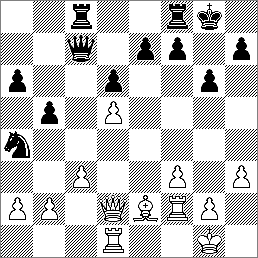 20…Rfd8
20…Rfd8
| Post: Tantamount to losing a valuable move, since White
by preventing the obviously intended ...e5, furthers his development, whereas
Black’s rook play is simply shelved at d8. Black’s subsequent play
is aimless and shifting in the extreme, giving the enemy an abundance of
time to build up an irresistible attack. Here, as well as later on,
he ought to have prepared for the advance of the a-pawn. |
| Kemeny: Loss of time. Better was ...a5, followed eventually
by ...a4 and ...a3. It must be admitted, however, that Black’s game was
somewhat compromised. |
| Kemeny: Not good, as Black’s ...Nd3 reply demonstrates.
White had an overwhelming advantage in position, and he could have easily
delayed the advance of the h-pawn. He should have played Re3.
If Black answers ...Na4, then R1e2 may be played. This play may be
followed up by h4 and h5. Black then will have no other defense than
giving up the e-pawn, which should decide in White’s favor. |
 34.Rf1
34.Rf1
| Kemeny: Very feeble. Having once let in the hostile knight,
which easily could have been excluded by 33.Re3, without impairing his
attack, since Black’s forces are helplessly dislocated, White should not
shy at a petty matter like the loss of a pawn, but boldly go on with his
rush. Not only would he then have won in better style, but made sure
of victory besides, whereas his own continuation left the issue in doubt.
In substantiation we give the main variations: 34.h5 Nxf4 if (34...Nxe1
35.Re6 with an overwhelming attack) 35.Re6 Nxh5 (if 35...Nxe6 36.Rxe6 wins)
36.Bf3 Ng7 37.R1e2 followed by Rh2 and wins. |
| Post: Black’s best defense seems 34...e5 with the following
likely continuation: 35.dxe6 Qg7 36.Rf1 or 36...Rc4 (36...Rce7 37.Rd2 Nc5
38.Rxd6 Nxe6 39.Bd5 Qxh6 40.gxh6 gxh5 41.Re1 Kf7 42.Rxa6 and wins) 37.e7
Nxf4 38.Rxf4 Rxf4 39.Bd5+ Kh8 40.Qxg7+ Kxg7 41.h6+ Kh8 42.Bf7 and wins. |
| Post: Now 35.Re6 Nxf4 36.Rxf4 Rxf4 would but lead to
a draw, for White no longer can advance h5, because of the crushing rejoinder
...Qa7+. But even if the h-pawn does not advance Black would still
play ...Qa7+, followed by ...Qf2, whereupon White must avail himself of
the perpetual check by Rxg6+. One sees how the first player has jeopardized
his game. |
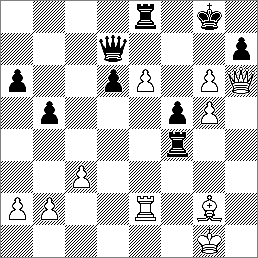 38…Qg7
38…Qg7
| Kemeny: A disastrous error, which loses the game. He should
have played ...Qa7+, followed by ...Qg7, which would have easily drawn
the game. |
| Post: Messrs. Kemeny, Stuart, and other Philadelphia
players rightly pointed out that prior to this move Black should have checked
at a7; White then would have been deprived of his most formidable continuation. |
| Kemeny: The winning move, but it could not be made if Black
had played ...Qa7+, first forcing the king to the h-file. White now
would have to guard against the threatening ...Rh4+ winning the queen. |
| Post: For with White’s king standing on the h-file this
move would have been impossible, because of the reply ...Rh4+. The
contention of the Philadelphians that the game then would have been a draw
was admitted by the judges, with the qualification that the draw is “a
difficult one and not easy to see.” Herein we concur; the draw is
quite difficult—for White. |
| Kemeny: 44...Rh1 should have been played. If White answers
Rf2, then ...Kg7, and if Rxf5, then ...Rg1+, followed by ...Rg2 or ...Rb1.
In fact, Black had still drawing chances. |
| Post: Again going amiss. His right play was ...Rh1,
whereupon an absolute win for White cannot be demonstrated. |
| Kemeny: 45...Rh1 was still in order, though the game could hardly
be saved. The play selected gives White an easy win. |
| Post: Black’s play from beginning to end is amateurish
in the extreme. With ...Rh1 instead, he at least would have died
harder. |
|
Philadelphia Public Ledger, 1899.09.22
|
|
American Chess Magazine, 1899.10-11,
p146
|
|
Fourth Round, Wednesday, August 30
| Penn. |
|
New York |
| Kemeny |
½-½
|
Marshall |
| Robinson |
½-½
|
Halpern |
| Young |
0-1
|
Lipschütz |
| Voigt |
1-0
|
Karpinski |
| Bampton |
½-½
|
Weeks |
| Shipley |
½-½
|
Hanham |
| McCutcheon |
1-0
|
Roething |
Total PA 4 NY 3
|
| The Pennsylvania team finally broke the deadlock
on the evening of Wednesday, August 30, 1899, when they managed to win
the round by a score of 4-3, bringing the total team points to 14½-13½.
Although four games were drawn, Pennsylvania won two of the remaining three,
one involving McCutcheon (of the McCutcheon Variation of the French Defense)
defeating Roething, while Voigt defeated the hapless Karpinski. New
York’s sole winner, of course, was once more Lipschütz, who now had
extended his score to 4-0 and clearly was the favorite to win the overall
first prize for individual scoring. Unfortunately, no games from
this round have been recovered. |
Fifth Round, Thursday, August 31
| New York |
|
Penn. |
| Roething |
0-1
|
Kemeny |
| Marshall |
1-0
|
Robinson |
| Halpern |
1-0
|
Young |
| Lipschütz |
1-0
|
Voigt |
| Karpinski |
1-0
|
Bampton |
| Weeks |
0-1
|
Shipley |
| Hanham |
½-½
|
McCutcheon |
Total NY 4½ PA 2½
|
| Pennsylvania’s small lead from the day before was
quickly extinguished as the New York delegation won four, lost two, and
drew one and thus themselves took a one point team score lead after five
rounds, 18-17. Lipschütz continued to run roughshod over his
opponents, winning his fifth game in a row (eight, if the three Staats-Zeitung
games against Marshall were included). Shipley finally won a game,
after four consecutive draws. Kemeny too won, bringing his score
to 3-2. Marshall’s win over D. Stuart Robinson left him with the
same score as Kemeny, and for the first time on the positive side of the
ledger. |
| Marshall’s win was annotated in the pages of the
October – November issue of the American Chess Magazine, by I. Gunsberg.
The notes were in all likelihood reprinted from another source, but none
was given. |
|
Marshall,FJ (New York) — Robinson,DS (Pennsylvania)
|
Round 5
|
| B34/02 |
Sicilian: Accelerated Dragon (Simagin)
|
|
| 1899.08.31 |
USA Saratoga Springs, NY (Interstate Team
Match)
|
|
Annotations by Isidor Gunsberg
1.e4 c5 2.Nf3 Nc6 3.d4 cxd4 4.Nxd4 Nf6 5.Nc3 g6 6.Bc4
Bg7 7.Nxc6 bxc6 8.e5 Ng8 9.Qe2 Qa5 10.Bf4 d5
| The game follows on the lines of some Sicilian defenses played by Janowski.
Black’s move is ingenious. He can safely pass the pawn, for if 11.exd6,
Bxc3+ would be a winning reply. |
| If 14...0-0 15.Nxd5 Qxd2 16.Nxe7+ and wins. |
| 15...0-0 at once is preferable with a view to advancing the c-pawn
afterward. If White worries by 16.Bh6 then 16...Nf5 is the reply. |
| Better than ...Qxe5, whereupon 18.Bf4 would win back the rook with
advantage. |
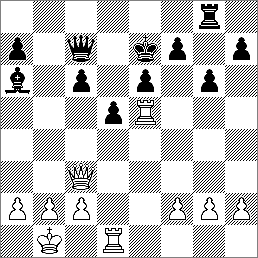 21.Rdxd5
21.Rdxd5
| Breaks the game to pieces. After neglecting to castle, Black
never got a chance, owing to White’s forcible tactics. |
| White threatened Qa3+, therefore ...Qb7 was not a good defense for
Black. |
| Black resigns, as mate in a few moves is inevitable. |
|
American Chess Magazine, 1899.10-11
|
|
| In addition to Marshall’s win, Kemeny’s victory
over Roething has also been recovered. Kemeny annotated his win for
the pages of the September 12, 1899, Philadelphia Public Ledger.
The Ledger wrote that “the game between Kemeny and Roething in the
recent interstate contest held at Saratoga was splendidly contested and
resulted in a victory for the former. Roething adopted a variation
of the Ruy Lopez involving the temporary sacrifice of a piece and a fairly
even game came about. On his fourteenth turn, however, he did not
select the strongest move, and by playing Be3 instead of Bf4, he gave Kemeny
an opportunity to gain the upper hand. The struggle from this point
was a very interesting one. The critical stage came about on the
twenty-third turn. The Philadelphian then could win a pawn, which,
however, would hardly have secured a win. Instead of winning a pawn
Kemeny selected a more forcible continuation, leading to the exchange of
both pawns, which gave him a winning endgame. After thirty-three
moves, Roething was obliged to acknowledge defeat. The game was entered
in the competition for the special brilliancy prize.” |
|
Roething (New York) — Kemeny,E (Pennsylvania)
|
Round 5
|
| C67/09 |
Spanish: Open Berlin (l’Hermet)
|
|
| 1899.08.31 |
USA Saratoga Springs, NY (Interstate Team
Match)
|
|
Annotations by Emil Kemeny
1.e4 e5 2.Nf3 Nc6 3.Bb5 Nf6 4.0-0 Nxe4 5.d4 Nd6 6.dxe5
| The unusual continuation is 6.Bxc6 followed by dxe5. The text
move involves the temporary sacrifice of a piece, and leads to interesting
complications. By correct defense, however, Black seems to obtain
the preferable game. |
| 7...Nd6 would win a pawn, but would badly compromise the Black game.
The text move, followed by ...Nxe5, is the best play for Black. |
| If Black tries to maintain his pawn by playing 9...f6, White may continue
Nh4, and he secures a powerful, if not winning, attack. The text
move is superior. Black gives up the pawn, but holds two bishops,
which gives him a slight advantage in the end game. |
| 11...Kxd8 is considered stronger, for it gives Black better chances
to guard the c-pawn. |
| Decidedly better was 14.Bf4. White tries to attack the a-pawn,
whereas he should have brought his forces to bear on the c-pawn.
The text move has also the disadvantage of preventing the retreat of the
rook. |
| Necessary, since ...Bxc3 followed by ...Rxc3 was threatened. |
| 20.Ne4 could hardly be played. Black might have answered ...Rxc2
or ...Be7, followed eventually by ...f5. |
| He could not play Rxa7 on account of ...Rxc3, Black winning a piece. |
 23…b5
23…b5
| Black might have played ...Bf5, winning a pawn, which, however, would
not have been as effective as the play adopted. White, by answering Re3,
and eventually Rce1, would have had excellent chances of holding his own.
The text move virtually forces a win. White cannot capture the b-pawn,
for ...Rcxc2 and eventually ...Bc4 follows. Nor can he play b4, for
...a5 and ...axb4 or ...b4 would lead to a win. There seems to be
no other reply than Re4, which leads to an exchange of both rooks, and
Black comes out with a winning endgame, White being unable to stop the
pawn on the queenside without sacrificing the knight. |
| 28.b3 would be answered by ...a4, followed by ...b3, ...b2, and ...Ba2,
Black winning the knight. |
| An important move. Had Black played ...a3, White could answer
b3, and he easily stops the pawns. The text move threatens ...a3,
and White has no valid defense. |
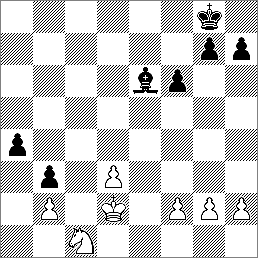 30…a3
30…a3
| The winning move. If White plays bxa3, which evidently was his
strongest play, then ...b2 follows, and Black wins the knight, coming out
with a bishop against the two scattered pawns. If, however, White
plays Nxb3, then ...axb2 and ...Bxb3 follows, Black having a piece against
a pawn. In either variation the win is an easy one. White,
of course, could not play Kc3, for ...a2 would win. |
| After this move White surrendered. A further struggle would be
quite useless, for ...Kf7, ...Ke6, and eventually ...Kf5 would win easily. |
|
Philadelphia Public Ledger, 1899.09.12
|
|
Sixth Round, Thursday, August 31
| Penn. |
|
New York |
| Kemeny |
1-0
|
Hanham |
| Robinson |
½-½
|
Roething |
| Young |
0-1
|
Marshall |
| Voigt |
1-0
|
Halpern |
| Bampton |
0-1
|
Lipschütz |
| Shipley |
½-½
|
Karpinski |
| McCutcheon |
0-1
|
Weeks |
Total PA 3 NY 4
|
| New York added to its one point lead in the evening
session on Thursday, thus taking into Friday’s final round a two point
team lead, 22-20. Though Pennsylvania was not mathematically eliminated
from winning the interstate contest, to do so they would need a 5-2 final
round victory over their rivals, or at least a 4½-2½ win
to tie the match. How this would be accomplished appeared difficult
to conceive. Lipschütz won again in round six, extending his
point total to an invincible 6-0. At the end of play Thursday, after
his victory over Bampton, he was guaranteed first prize for his individual
achievement. Pennsylvania’s only hope was that Shipley, who had not
been beaten in the team match, though he sported only a 3½-2½
score, might help slow the New Yorker down. Marshall, too, had improved
his record to 4-2, matching Kemeny, the best scorer for the Pennsylvania
team, and thus along with Lipschütz accounted for ten of New York’s
twenty-two points at the end of round six. |
 |
H. G. Voigt
|
Hermann Voigt, the very strong Pennsylvania player,
whose form had been terrible during the tournament, won his sixth round
game against Halpern. Gustavus Reichhelm’s annotations to the game,
no doubt from his column in the Philadelphia Times, appeared in
the October - November issue of the American Chess Magazine. |
|
|
Voigt,HG (Pennsylvania) — Halpern,JC (New York)
|
Round 6
|
| C01/03 |
French: Exchange (Svenonius)
|
|
| 1899.08.31 |
USA Saratoga Springs, NY (Interstate Team
Match)
|
|
Annotations by Gustavus Reichhelm
1.e4 e6 2.d4 d5 3.Nc3 Nf6 4.exd5 exd5 5.Nf3 Bd6 6.Bd3
0-0 7.0-0 c6 8.Ne2 Ne4 9.c4 f5
| Here 9...Be6 is safer. Against the move in the text White’s best
course is Qb3. |
| Protecting the pawn, for its capture would entail loss of the queen,
through ...Bxh2+. |
| The slight advantage obtained by White in the opening is improved step
by step and culminates in a brilliant win. |
 25.Rxc8
25.Rxc8
| The beginning of a fine and sound coup. |
| He should have retried ...Rd8, but even then Black could not have saved
the game, as White would equally reply with Ne5. |
| The position is as pretty as a problem. On the Black rook moving,
White rejoins with Rxd4, followed by Nc6+ on the rook retaking. |
|
American Chess Magazine, 1899.10-11
|
|
| Kemeny annotated his win against Hanham for the
pages of the September 5, 1899, issue of the Philadelphia Public Ledger.
His annotations were reprinted in the American Chess Magazine for
October - November 1899. If there had been talk about Kemeny’s fifth
round win against Roething being submitted for the best game prize, his
win in the next round against Hanham was thought by many to be sure to
win the award. The
Ledger introduced the game by writing that
“up to the twenty-fourth move the play was extremely conservative on both
sides, the Philadelphian, however, securing the preferable development.
The play became complicated when Kemeny on the twenty-fifth turn advanced
the a-pawn, which induced his opponent to sacrifice a pawn. Hanham
calculated to win the exchange, for apparently the rook had no retreat.
Kemeny, however, had quite a brilliant continuation on hand when on his
thirty-first turn he offered the sacrifice of a knight. This completely
demolished Hanham’s defense. He soon lost the g-pawn and h-pawn,
and on the forty-third turn he surrendered. The game is quite likely
to be awarded the special prize offered by President Martinez for the winner
of the best contested game.” |
 |
J. M. Hanham
|
|
| While the Ledger’s assumption the game would
win the silver smoking set was premature, the game Kemeny had played was
quite attractive in its own right. |
|
Kemeny,E (Pennsylvania) — Hanham,JM (New York)
|
Round 6
|
| 1899.08.31 |
USA Saratoga Springs, NY (Interstate Team
Match)
|
|
Annotations by Emil Kemeny
1.e4 e5 2.Nf3 d6 3.d4 Nd7 4.Bd3 Be7 5.Be3 Ngf6 6.c3 c6
7.Nbd2 Qc7 8.Qc2 0-0 9.0-0 Re8 10.Nc4 Bd8 11.a4 Nf8 12.a5 Ng6 13.b4 Be6
14.dxe5 dxe5 15.Rfd1 Nd7 16.Be2 Be7 17.Rd2 Ndf8 18.Rad1 h6 19.Nd6 Red8
20.Nf5 Rxd2 21.Nxe7+ Qxe7 22.Qxd2 Nd7 23.Qd6 Qxd6 24.Rxd6
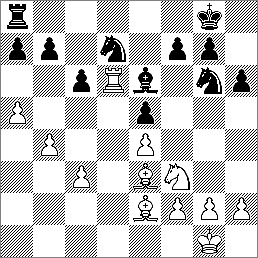 24…Kf8
24…Kf8
| Black evidently should have played ...a6, in order to stop the threatening
a6. It is quite likely, however, that Black intended to give up the
c-pawn expecting to close in the White rook. It must be admitted,
however, that White at this stage had the preferable game; the two bishops
are powerful and the rook occupies the open file, and if Black moves ...a6
his b-pawn becomes rather weak. |
| He could not play 24...Kd8, for White answers 25.Rxa7. If then
25...Rxa7, White continues 26.Bxb6+ and 27.Bxa7, or if Black interposes
the rook, then 27.a7 and queening of the pawn follows. |
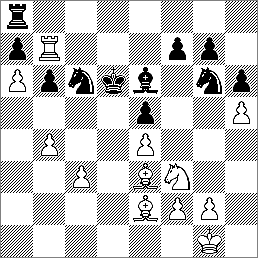 30…Nge7
30…Nge7
| Black now threatens ...Nd8 or ...Bc8 winning the exchange. White,
however, has the Nd4 continuation on hand, which wins. If Black plays 31...exd4,
then 32.Bf4+ and cxd4 follow; if, however, 31...Nxd4, then 32.cxd4 leads
to a similar continuation. Black cannot avoid this play. If he moves
31...Bc8, then 32.Nb5+ Ke6 33.Nc7+ wins the rook. |
| Causes Black to surrender; he cannot stop the h-pawn without sacrificing
a piece. |
|
Philadelphia Public Ledger, 1899.09.05
|
|
American Chess Magazine, 1899.10-11
|
|
Seventh Round, Friday, September 1
| New York |
|
Penn. |
| Weeks |
½-½
|
Kemeny |
| Hanham |
1-0
|
Robinson |
| Roething |
1-0
|
Young |
| Marshall |
½-½
|
Voigt |
| Penn. |
|
New York |
| Bampton |
½-½
|
Halpern |
| Shipley |
½-½
|
Lipschütz |
| McCutcheon |
½-½
|
Karpinski |
Total NY 4½ PA 2½
|
| So as not to favor either team by awarding their
whole squad the White pieces for the fourth time in seven rounds, the seventh
and final round of the interstate match was divided as to who had White,
with four New York players and three Pennsylvania players retaining that
small opening advantage. But the allocation of colors did not really
change the situation. The Pennsylvania team could not reach at least
4½-2½ in order to tie the match, let alone the 5-2 score
needed to win it. Instead they found themselves losing the round
by a two point margin. For the first and only time, one team, Pennsylvania,
did not score a win in a round. On the other hand, Lipschütz
was prevented from traveling home with a perfect record. Pennsylvania’s
team captain, Shipley, held him to a draw. As Lipschütz acted
as New York’s team captain, perhaps the draw was not fully unexpected between
the two. New York thus won the match by a score of 26½-22½.
No games from the seventh and final round have survived. |
| In terms of individual scoring, Lipschütz received
the forty dollar first prize for his exceptional score of 6½-½.
Marshall and Kemeny divided second and third prizes (twenty-five and twenty
dollars, accordingly), for their scores of 4½-2½ each.
Shipley, Halpern, and Bampton, at 4-3, were left to divide the fourth and
fifth prizes of ten and five dollars. As is well known, however,
Shipley never accepted a cash prize for his chess play in any event during
his long career, and so in all likelihood Halpern and Bampton were left
to divide the last two prizes. The one hundred dollars in prize money
had been raised through each state chess association placing fifty dollars
in the prize fund. |
| Besides the fight for the Staats-Zeitung Chess Cup
as well as for the third annual New York versus Pennsylvania team match
title, a General Tournament was held by the NYSCA during the midsummer
meeting at Saratoga Springs. The General Tournament was itself divided
into three separate classes, and the winner of the First Class tournament
was W. J. Ferris of Newcastle, Delaware, a member of the Franklin Chess
Club. Only five players entered the First Class event, and the deciding
game was between Ferris and Waller, one of the players who tied for second
and third prize in the event. The final round game that follows gave
Ferris the Farnsworth Cup for the year. |
| The Philadelphia Public Ledger for September
8, 1899, reported that “the game between Ferris and Waller in the final
round of the New York State tourney recently held at Saratoga was a French
Defense, won by the former. Waller failed to select the strongest
moves and he lost a valuable pawn on the twenty-first turn. Ferris
pursued his advantage vigorously; he won an exchange and subsequently a
piece. Waller surrendered on the forty-third turn, when his position
was a hopeless one. By winning this game Ferris secured first prize.”
The annotations are by Emil Kemeny. |
| C16/01 |
French: Advance Winawer
|
|
| 1899.09 |
USA Saratoga Springs, NY (General Tournament,
First Class)
|
|
Annotations by Emil Kemeny
1.e4 e6 2.d4 d5 3.Nc3 Bb4
| The usual play is 3...Nf6, which in all probability is superior to
the text move. |
| Better was 19...f6. If White plays exf6, then ...Bxf6 and eventually
...e5 follows. If, however, White answers f4, then ...fxe5 and ...Rdf8
leads to an even game. |
| 20...f6 was still in order. The play adopted by Black causes
the loss of a valuable pawn. |
| To guard against the threatening g5. The move, however, is inferior,
for White plays Qf4, which forces away the knight. Better, perhaps,
was ...Be8. If then White plays g5, Black may play ...Rxh5 and then
sacrifice the exchange. |
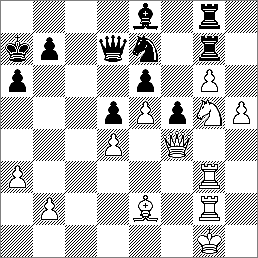 37…Bxg6
37…Bxg6
| Black had a rather difficult game to defend. White threatened
Nh7 and Nf6, after which the advanced pawns could hardly be stopped.
The sacrifice, while not sound, gives some chances of escape. If
White answers hxg6, then ...Nxg6 and eventually ...f4 may follow.
White, however, selects a more forcible continuation. By moving h6
he wins the exchange with an overwhelming attack. |
| He could not save the piece. If ...Rxg7, then White answers Rxg7
and eventually h7. The text move may be answered by Rxd7, followed
by Rxg8, and eventually by h7, or by R2xg6. Either play wins easily. |
| Had White played 43. Rxh7, then ...Qg6+ and ...Qxh7 might have prolonged
the battle. The text move virtually ends the game. Black is
a rook behind and cannot save the bishop. |
|
Philadelphia Public Ledger, 1899.09.08
|
|
| Thus ended the NYSCA midsummer meeting at Saratoga
Springs in late August and early September 1899. But the end of the
meeting did not mean the end of controversy. There was still the
matter of the prize for the best played game. |
| William de Visser and Philip Richardson, both of
Brooklyn, were named as a committee of two to determine who should receive
Manhattan Chess Club President Ariztides Martinez’s special prize for the
best played game at Saratoga. After examining the various game scores
submitted for the silver smoking set, de Visser and Richardson originally
decided that Emil Kemeny of Philadelphia deserved the prize for his sixth
round victory over Hanham. |
| The problem, it developed, was that not every score
originally set aside for consideration had actually been seen by de Visser
and Richardson. Fourteen of the forty-nine games played were in fact
intended for submission for the prize, but only thirteen made their way
to the committee. The score of Lipschütz’s victory over D. Stuart
Robinson had in fact been mislaid, and not turned over to the two men.
To complicate matters further, before learning the Lipschütz game
had not been submitted, de Visser had spoken with someone associated with
the press stating that it appeared the Kemeny game would win the prize,
though he asked the reporter not to divulge this information until after
the official announcement had been made. Either “through bad faith,
or, at least, a misunderstanding,” several newspapers announced that Kemeny
would win the smoking set. |
| But once the Lipschütz – Stuart Robinson game
score was found (in fact, Robinson had to be written concerning the matter,
and he graciously sent along from Philadelphia a copy of his own scoresheet),
de Visser and Richardson considered that game to be superior in merit to
the Kemeny game, and thereafter officially announced that Lipschütz,
and not Kemeny, would receive the special prize for the best played game. |
| The matter of the mislaid game score aside, the
reports of the midsummer meeting at Saratoga Springs were uniformly favorable,
but for one by Marshall, who grumbled at one point that because his room
“fronted toward a railway terminus which caused the puffing and blowing
of the locomotives to scare the wits out of Morpheus,” he had no sleep
during the event. |
| Marshall’s complaint, or excuse, depending upon
how one wishes to read it, was not directly remarked on by the editor of
the American Chess Magazine. The editor did, however, note
that it had come under question whether “the famous resort is exactly the
proper place for this meeting,” and that he had heard “players attribute
indifferent success on the board to the gayety of the surroundings, the
general restlessness in the atmosphere and to too much style.” The
general editorial conclusion, though, was that considering “that a fair
proportion of the contestants accomplished excellent results, this argument
cannot very well be entertained and it must be taken for granted that there
was something, either in the temperament or ability of the players themselves,
to account for the non-success of which they complained.” Or to put
the matter another way, essentially every chess player faced the same challenge
a stay at a popular summer resort offered. |
| Saratoga Springs 1899 produced no opening novelties.
It was not of international master standards, nor did it intend to be.
What it did illustrate, however, was how much fun could be had, if only
for a short time, in an interstate meeting of chessplayers united in their
love of the game and in their mutual respect for the abilities of their
compatriots and their fellow competitors, alike. That good chess
in a number of games took place was, to some extent, secondary to the communal
sense of a united effort. And perhaps, just perhaps, at the club
level, that is how much of chess should be played, and enjoyed. |
|
| * Whether Albert Beauregard Hodges ever legitimately
held the title of United States Champion should be a subject of some controversy
among American chess history scholars. I am indebted to Nick Pope
for first bringing the issue to my attention. The generally held
view is that Hodges did hold the title, but this conclusion is based upon
the assumption that Lipschütz, the previous title holder, had in fact
given up his crown when he moved out West for reasons of health. Lipschütz
would later deny that he had abdicated, thus casting into doubt the legitimacy
of Showalter having again assumed the title prior to the moment Hodges
defeated him in a match. Hodges did, however, resign his title, or
at least his claim to it, shortly thereafter, due to the pressure of his
business commitments, and Showalter took up the title once more.
Any question as to Showalter’s later supremacy over Lipschütz was
answered in a subsequent match between the two, played once Lipschütz
had returned East. This article, however, is not the place to attempt
a detailed evaluation concerning such matters. They involve complex
questions of pedigree, ones requiring long and careful study of the historical
record as it pertains to the high throne of American chess. |
|
|
|
© John S. Hilbert 2000. All rights
Reserved.
|























